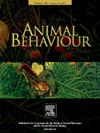Geographical variation in parental calls contextually shapes nestling songbird responses
IF 2.3
2区 生物学
Q2 BEHAVIORAL SCIENCES
引用次数: 0
Abstract
In species expressing parental care, juveniles often utilize cues from their parents to distinguish between safe and dangerous situations. For example, nestling songbirds beg in response to parental feeding cues but stop vocalizing in response to parental alarm calls. Previous studies have shown that nestling birds discriminate between calls of their own and other species. However, it is unknown whether and how nestlings discriminate call variation across populations within their own species. Adult pied flycatchers, Ficedula hypoleuca, produce acoustically identical calls at a fast rate when a predator is nearby, and slowly during feeding visits, potentially signalling the level of danger near the nest. Taking advantage of this functional duality, our study examines whether nestling discrimination of call variation across populations depends on the context in which they are produced. In response to rapidly repeated predator-associated calls, we found that nestlings reduced begging activity similarly, whether calls were from local or foreign populations. Conversely, in response to slowly repeated feeding-associated calls, nestlings begged more in response to local than foreign conspecific calls. Our results show that nestlings discriminate within-species call variation but adjust their response threshold depending on the call context, which we argue may optimize their begging activity in order to get fed, while simultaneously avoiding predation. This study underscores the importance of studying the effects of within-species variation in nonmating signals, such as calls, on songbird behaviour.
求助全文
约1分钟内获得全文
求助全文
来源期刊

Animal Behaviour
生物-动物学
CiteScore
4.60
自引率
8.00%
发文量
236
审稿时长
10.2 weeks
期刊介绍:
Growing interest in behavioural biology and the international reputation of Animal Behaviour prompted an expansion to monthly publication in 1989. Animal Behaviour continues to be the journal of choice for biologists, ethologists, psychologists, physiologists, and veterinarians with an interest in the subject.
 求助内容:
求助内容: 应助结果提醒方式:
应助结果提醒方式:


